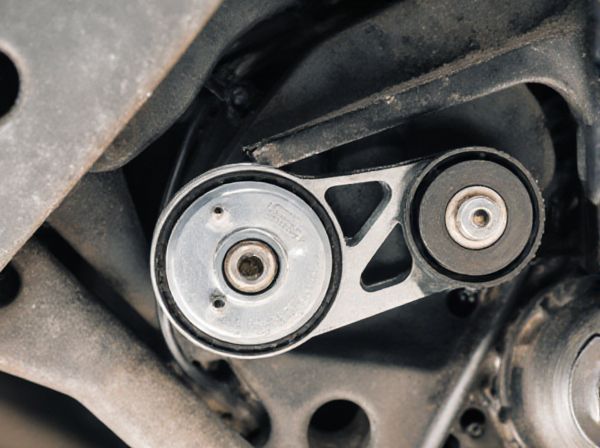
Photo illustration: Hydraulic Tensioner vs Mechanical Tensioner
Hydraulic tensioners use fluid pressure to maintain constant tension on the belt, ensuring smoother operation and reducing wear. Mechanical tensioners rely on springs and manual adjustment, which may require periodic maintenance to keep optimal tension. Choosing the right tensioner affects Your engine's performance and longevity by providing consistent belt tension under varying conditions.
Table of Comparison
| Feature | Hydraulic Tensioner | Mechanical Tensioner |
|---|---|---|
| Tensioning Method | Uses hydraulic fluid pressure for automatic adjustment | Spring or lever-based manual tension adjustment |
| Maintenance | Low maintenance, self-adjusting | Requires periodic manual adjustment |
| Lifespan | Typically lasts the timing belt lifespan (60,000-100,000 miles) | Can wear faster due to manual tension variations |
| Cost | Higher initial cost due to complexity | Lower upfront cost and simpler design |
| Noise Level | Quieter operation with consistent tension | May produce noise from loose or tight tension |
| Performance | Ensures optimal timing belt tension for engine efficiency | Risk of improper tension affecting engine timing |
Overview of Hydraulic and Mechanical Tensioners
Hydraulic tensioners use pressurized oil to maintain consistent tension on timing or serpentine belts, providing automatic adjustment and reducing vibration for improved engine performance. Mechanical tensioners rely on springs or manual adjustment to maintain belt tension, requiring periodic checks and adjustments to ensure proper functionality. Hydraulic tensioners generally offer smoother operation and longer service intervals compared to mechanical tensioners, which are simpler in design and cost-effective.
How Hydraulic Tensioners Work
Hydraulic tensioners use engine oil pressure to automatically maintain optimal tension on timing belts or chains, ensuring consistent performance and reducing wear. Unlike mechanical tensioners that rely on spring force, hydraulic tensioners adjust tension dynamically in response to changes in engine load and temperature. This real-time adjustment improves belt longevity and helps prevent slippage or noise during engine operation.
How Mechanical Tensioners Work
Mechanical tensioners use a spring or lever mechanism to maintain constant tension on a belt or chain by automatically compensating for wear and elongation. They rely on the physical force of the spring to apply pressure, ensuring the timing belt or chain remains tight without the need for hydraulic fluid or external adjustments. This straightforward design makes mechanical tensioners durable and easier to install compared to hydraulic tensioners, which use fluid pressure to adjust tension.
Key Differences Between Hydraulic and Mechanical Tensioners
Hydraulic tensioners use oil pressure to maintain consistent tension on the timing belt or chain, providing automatic adjustment and smoother operation, which reduces wear and noise. Mechanical tensioners rely on springs or manual adjustment mechanisms, requiring periodic checks and adjustments to maintain proper tension. Hydraulic tensioners offer better durability and performance in high-stress environments compared to mechanical tensioners, making them ideal for modern engines with variable load demands.
Performance and Reliability Comparison
Hydraulic tensioners provide consistent chain tension by automatically adjusting to engine load and temperature changes, offering superior performance in maintaining optimal timing chain alignment. Mechanical tensioners rely on spring force, which can degrade over time, leading to less precise tension and increased risk of chain slack or noise, affecting long-term reliability. Hydraulic tensioners generally outperform mechanical ones in durability and maintenance intervals, making them preferred in high-performance and modern engine applications.
Maintenance Requirements for Each Tensioner Type
Hydraulic tensioners require regular inspection of hydraulic fluid levels and condition to maintain proper tension and prevent leaks, while seals and hoses must be checked for wear. Mechanical tensioners demand periodic adjustment and lubrication of moving parts to ensure consistent belt tension, with components like springs and pulleys monitored for signs of fatigue or damage. Both tensioner types benefit from routine maintenance schedules, but hydraulic systems necessitate more frequent fluid-related upkeep compared to the primarily mechanical servicing of mechanical tensioners.
Cost Analysis: Hydraulic vs Mechanical Tensioners
Hydraulic tensioners generally have higher upfront costs due to complex internal components and require periodic maintenance, increasing long-term expenses, whereas mechanical tensioners are typically less expensive initially and offer lower maintenance costs but may need more frequent adjustments or replacements. The choice impacts overall cost-effectiveness depending on application demands, with hydraulic tensioners providing better performance in high-stress environments, justifying their higher investment. Mechanical tensioners remain cost-efficient for lower-stress applications requiring simpler, budget-friendly solutions.
Common Applications and Industry Usage
Hydraulic tensioners are commonly used in automotive engines and heavy machinery where precise tension control and automatic adjustment are crucial for maintaining optimal belt or chain tension under varying loads. Mechanical tensioners find widespread application in simpler systems such as bicycles, light machinery, and some industrial equipment where manual adjustment suffices and cost-efficiency is prioritized. In industries like manufacturing and automotive repair, hydraulic tensioners are preferred for high-performance engines, while mechanical tensioners dominate in low to medium-demand environments.
Pros and Cons of Hydraulic Tensioners
Hydraulic tensioners provide consistent tension through fluid pressure, reducing vibration and increasing belt lifespan, making them ideal for high-performance or heavy-duty engines. Their self-adjusting capability minimizes maintenance needs, but hydraulic systems can be prone to leaks and require quality fluid, raising long-term operational costs. Compared to mechanical tensioners, hydraulic tensioners offer smoother operation but have higher initial investment and complexity.
Pros and Cons of Mechanical Tensioners
Mechanical tensioners offer a straightforward design with lower initial costs and ease of installation, making them accessible for many engine types. However, they require more frequent maintenance and manual adjustment to maintain optimal belt tension, which can lead to premature wear and reduced lifespan. Their lack of automatic compensation for belt stretch or thermal expansion often results in inconsistent tension, potentially impacting engine performance and part durability.
 caratoz.com
caratoz.com